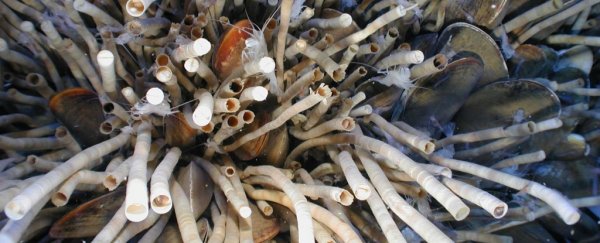Make some room tortoises and whales, because it looks like tubeworms have the real secret to longevity. A new study has found that these deep-sea animals from the Gulf of Mexico can live to be between 100 and 300 years old.
"At more than 250 years old, Escarpia laminata achieves a lifespan that exceeds other longevity records," says lead researcher Alanna Durkin from Temple University in the US.
Here on land, the longest-living vertebrate is the Galapagos giant tortoise (Chelonoidis nigra) with one example pegged at 177 years old. When it comes to mammals, the Bowhead whale (Balaena mysticetus) takes the top place for longevity at 211 years old.
But if you really want to live a long life, the deep sea is the place to be for living at a slower pace. Here you will find black corals (Antipatharia) that are more than 4,000 years old, and rockfish that can live up to 205 years.
There's even an octopus (Graneledone boreopacifica) that holds the record for the longest ever egg-brooding time at a staggering 53 months.
And let's not forget Ming the clam, an ocean quahog (Arctica islandica) that lived until the grand old age of 507 years.
In amongst these old-timers are also tubeworms living on the ocean floor in cold seeps, which spew out hydrogen sulfide, methane and other hydrocarbon-rich fluids.
Some tubeworm species, like Lamellibrachia luymesi and Seepiophila jonesi, live up to 250 years, relying on nothing more than sulfide-oxidising bacteria for all their nutritional needs.
If this lifestyle isn't weird enough, tubeworms break all the rules when it comes to figuring out why they live for so long. Often, body size and ambient temperature can be used to predict lifespan in animals, but tubeworm death rates are much lower than expected based on this model.
Another idea that could explain why these worms stick around for the long haul is longevity theory, which states that natural selection will favour individuals that age slowly and reproduce into old age when there are no threats.
To see where tubeworm lifespans fit in, Durkin and her team investigated Escarpia laminata tubeworms, which are found up to 3,300 metres (10,820 feet) deep in Gulf of Mexico.
The researchers marked six clusters of E. laminata in various locations and collected 356 of the tubeworms a year later. The team also revisited some other tubeworms they measured over a span of 15 years to compare growth rates.
After measuring how much the tubeworms had grown over each period, the researchers used the data to construct a model describing annual growth and death rates to estimate their age.
It turns out that these tubeworms are masters at cheating death, with only 0.67 percent dying annually.
The researchers also estimated a 50 centimetres (20 inch) tubeworm to be around 116 years old, much older than their shallower relatives at the same length.
With this in mind, the team predicted that E. laminata tubeworms can easily live beyond 250 years, outliving both L. luymesi and S. jonesi.
"Given the uncertainty associated with estimating the ages of the longest individuals, there may be large Escarpia laminata tubeworms alive in nature that live even longer," says Durkin.
In addition to winning a place amongst the longest-living animals in the world, the researchers say that the results support longevity theory and reveal new insights about the evolution of life history strategies.
But only time will tell if the tubeworm will outlive Ming the clam.
The research is published in The Science of Nature.
